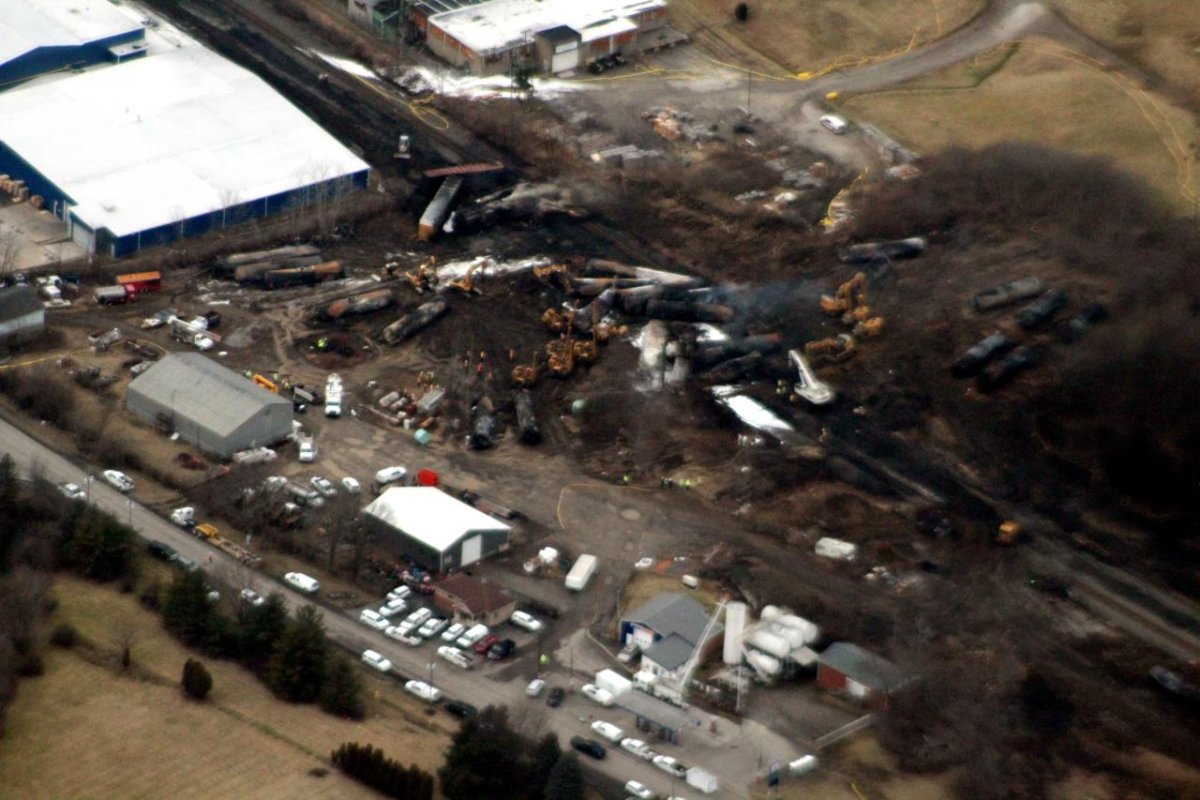The Environmental Protection Agency (EPA) published a full list of toxic chemicals that were released when a cargo train derailed near the border between Ohio and Pennsylvania on February 3.
At about 8:55 p.m. ET, a Norfolk Southern train of around 150 cars derailed near the Ohio town of East Palestine, 20 of those cars carrying hazardous materials.
The derailment caused a huge fire and, fearing a massive explosion that would release noxious gases and shrapnel into the surrounding area, emergency responders intentionally breached five cars to let out the chemicals inside.
The chemicals were diverted into a trench and burnt off. Officials warned, however, that it would send toxic gases phosgene—used during World War I—and hydrogen chloride into the atmosphere.
Environmental regulators have been monitoring the air and drinking water around the site of the derailment, and have so far said both remain unaffected by the spill.

Residents of East Palestine were allowed to return to their homes after chemicals observed in the atmosphere following the controlled release were found to be at safe levels. Some have complained of headaches and nausea, according to the Associated Press, and pets have died in suspected cases of chemical exposure.
In a February 10 letter sent by Jason El-Zein, an emergency response manager at the EPA, to Matt Gernand, deputy general counsel for the Norfolk Southern Railway Company, a list of toxic chemicals were identified as having been found to have contaminated air, soil or water surrounding the crash site. They were:
- Vinyl chloride: a colorless gas that is used to make polyvinyl chloride (PVC) plastics and is highly flammable and decomposes to make toxic fumes. According to the National Library of Medicine, it is also carcinogenic and can cause other health issues.
- Butyl acrylate: a clear liquid that is used for making paints, sealants and adhesives. It is flammable and can cause skin, eye and respiratory irritation.
- Ethylhexyl acrylate: a colorless liquid used to make paints and plastics. It can cause skin and respiratory irritation and, under moderate heat, can produce hazardous vapor.
- Ethylene glycol monobutyl: a colorless liquid used as a solvent for paint and inks, as well as some dry cleaning solutions. It is classed as acutely toxic, able to cause serious or permanent injury, and highly flammable. Vapors can irritate the eyes and nose, and ingestion can cause headaches and vomiting.
The EPA also published a list of cargo from Norfolk Southern in the cars involved in the derailment, which showed a similar array of chemicals to those identified by the EPA. It showed petrochemicals had also been lost in the blaze, as well as a hopper of semolina and a box car of frozen vegetables.
El-Zein wrote that the EPA "has spent, or is considering spending, public funds to investigate and control releases of hazardous substances or potential releases of hazardous substances" and had determined that the rail company "may be responsible under [the Comprehensive Environmental Response, Compensation, and Liability Act] for clean-up of the site or costs EPA has incurred in cleaning up the site."
When asked to comment, a Norfolk Southern spokesperson told Newsweek that the company had received the EPA's letter "and we have confirmed to them that we have and will continue to perform or finance environmental monitoring and remediation.
"Our hazmat team was in East Palestine within an hour of the incident, and the response continues today in close coordination with the Ohio and U.S. EPA," as well as other agencies, they added.
The company is also facing a lawsuit, filed by two Pennsylvania residents on Thursday, calling for the rail operator to pay for medical screenings for anyone within a 30-mile radius of the crash site alongside damages. The rail operator has declined to comment on the lawsuit. The EPA is already assisting health screenings offered by Norfolk Southern.

Officials expressed calm when lifting evacuation orders, with Ohio Governor Mike DeWine describing air quality readings as "basically similar to what they would have expected prior to the train wreck" during a press conference.
Kirk Kollar of the Ohio EPA said the levels of toxic chemicals observed in nearby waterways "were immediately toxic to fish," and that spilt material had leaked into Sulphur Run. Lesley Run, Little Beaver Creek and the Ohio River were being monitored.
The U.S. EPA said on Friday that Norfolk Southern contractors had installed a dam and a water bypass at Sulphur Run to prevent further contamination, and had also stopped the remaining spilled chemicals entering the stream.
The EPA is working with the Ohio EPA to investigate soil contamination at the derailment site.
Update 02/13/23, 11:50 a.m. ET: This article was updated to include comment from Norfolk Southern.
Uncommon Knowledge
Newsweek is committed to challenging conventional wisdom and finding connections in the search for common ground.
Newsweek is committed to challenging conventional wisdom and finding connections in the search for common ground.
About the writer
Aleks Phillips is a Newsweek U.S. News Reporter based in London. His focus is on U.S. politics and the environment. ... Read more
To read how Newsweek uses AI as a newsroom tool, Click here.








